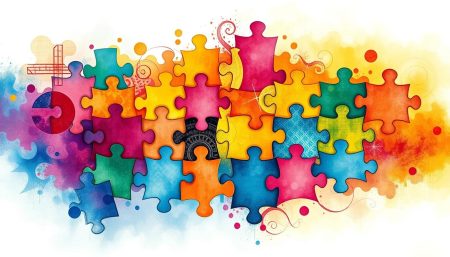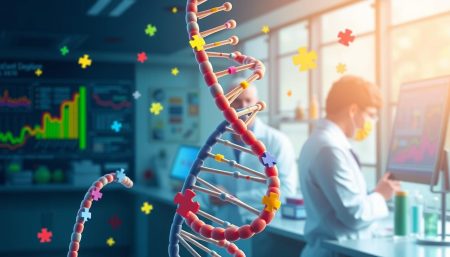Autism spectrum disorder (ASD) is a complex condition that affects how people communicate and behave. It impacts how they interact with others. Each person’s experience is unique, with a wide range of skills and support needs.
ASD symptoms vary greatly from person to person. Some may need a lot of support in daily life. Others might live independently. Early detection of autism characteristics is key for the right support.
Understanding the autism spectrum helps us accept and include everyone. By recognizing the strengths and challenges of ASD, we can better support those on the spectrum. This way, we celebrate neurodiversity in our communities.
What Is the Autism Spectrum: A Comprehensive Overview
The way we define the autism spectrum has changed over time. This change shows how much we’ve learned about this complex condition. Each person with autism has their own set of traits, making their experience unique.
Definition and Basic Concepts
Autism Spectrum Disorder (ASD) is a condition that affects how people communicate and behave. It also impacts how they process sensory information. The autism spectrum includes a wide range of abilities and challenges, with no two people being the same.
The Spectrum Model Explained
The spectrum model shows the variety of autism traits. It’s not a simple scale from mild to severe. Instead, it’s a complex concept that looks at different areas of life, like communication and motor skills.
Moving Beyond Linear Understanding
Today, research on autism focuses on a more detailed view of the spectrum. Experts now see autism as a collection of traits, not just a single line. This new understanding helps tailor support to meet each person’s needs.
It’s important to understand the autism spectrum to promote acceptance and support. By seeing the diversity within ASD, we can better appreciate the unique qualities of each person on the spectrum.
Historical Evolution of Autism Spectrum Understanding
Our understanding of autism spectrum conditions has grown a lot. In the 1940s, two researchers, Leo Kanner and Hans Asperger, described similar behaviors in children. Their work started our modern understanding of autism.
Kanner described “autistic disturbances of affective contact” in children who liked objects more than people. Asperger talked about children with good language skills but social problems. Their early work shaped the field for many years.
The 1960s and 1970s changed how we saw autism. It was no longer thought of as childhood schizophrenia. Instead, it was seen as a developmental disorder. This change led to new ways to diagnose and treat it.
In the 1980s, we started to see autism as a spectrum. This idea showed that autism affects people in different ways. The spectrum model helps us understand the wide range of abilities and challenges in autism spectrum conditions.
| Decade | Key Development |
|---|---|
| 1940s | First clinical descriptions by Kanner and Asperger |
| 1960s-1970s | Autism recognized as a developmental disorder |
| 1980s | Introduction of the autism spectrum concept |
| 1990s-2000s | Expanded research and public awareness |
| 2010s-Present | Focus on neurodiversity and individualized support |
Today, our understanding of autism spectrum conditions keeps growing. We’re learning more about early detection and how to help people throughout their lives. We’re also focusing on the unique strengths and perspectives of people with autism.
Core Characteristics of Autism Spectrum Disorder
Autism Spectrum Disorder (ASD) is a complex condition with unique autism characteristics. These traits affect people in different ways. Knowing these core features is essential for recognizing and supporting ASD.
Social Communication Patterns
Those with ASD often struggle with social interactions. They might find it hard to read facial expressions or understand social cues. Starting or keeping conversations can also be a challenge.
Behavioral Patterns and Interests
Repetitive behaviors and intense interests are common in ASD. This could mean repeating actions or words, or having a strong interest in specific topics. Some individuals may insist on strict routines and get upset by changes.
Sensory Processing Differences
Many with ASD experience the world differently through their senses. They might be very sensitive to sounds, lights, or textures. Some may seek out certain sensory experiences, while others avoid them.
| Area | Common ASD Symptoms |
|---|---|
| Social | Difficulty with eye contact, trouble understanding jokes |
| Behavioral | Repeating words or actions, strong attachment to objects |
| Sensory | Oversensitivity to noise, preference for specific textures |
These core traits can vary widely among individuals. Some might need more support, while others may manage independently. Recognizing these autism characteristics helps in providing tailored support and understanding for those on the spectrum.
Different Levels of Support Needs in ASD
It’s key to understand the support needs for those with autism spectrum conditions. The DSM-5 outlines three levels of support needs. Each level shows different traits of autism spectrum.
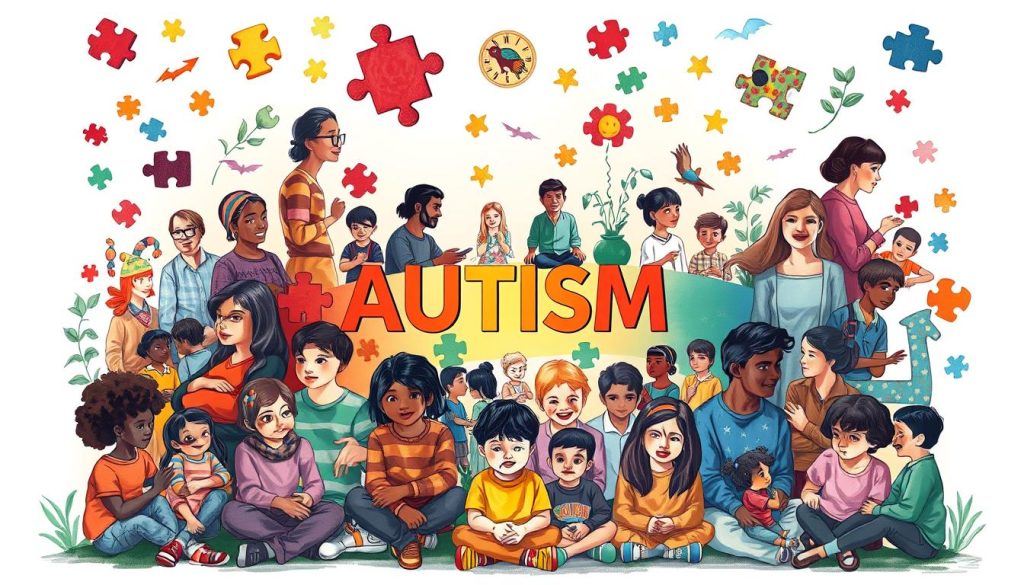
Level 1: Requiring Support
At this level, people face mild challenges in social communication and flexibility. They might find it hard to start conversations or adjust to new things. Yet, with some help, they can manage on their own in many life areas.
Level 2: Requiring Substantial Support
Those at this level have more obvious problems with talking and nonverbal communication. They often have narrow interests and find it tough to handle changes in routine. They need a lot of support to get through daily life and social interactions.
Level 3: Requiring Very Substantial Support
This level shows severe challenges in social communication and big trouble with change. People might not talk much and repeat actions a lot. They need a lot of support in all parts of daily life.
| Support Level | Social Communication | Restricted/Repetitive Behaviors |
|---|---|---|
| Level 1 | Noticeable difficulties without support | Inflexibility causes some interference |
| Level 2 | Marked deficits even with support | Inflexibility and difficulty coping with change |
| Level 3 | Severe deficits causing significant impairment | Extreme difficulty coping with change |
It’s vital to remember that support needs can change in different areas for people with autism. Regular checks help make sure they get the right support as their needs evolve.
Common Signs and Symptoms Across the Spectrum
Autism spectrum disorder (ASD) shows a wide range of signs and symptoms. It’s key to spot these early for help and support. These signs often start in early childhood and can last a lifetime.
People with ASD often face challenges in social interactions. This can include:
- Difficulty maintaining eye contact
- Trouble understanding social cues
- Challenges in forming and keeping friendships
Communication is also different for those with ASD. They might:
- Have delayed language development
- Use repetitive or unusual speech patterns
- Struggle with back-and-forth conversations
Behavioral patterns are another key part of ASD. These can include:
- Repetitive movements or actions
- Intense focus on specific interests
- Adherence to strict routines
Sensory sensitivities are common in ASD. People might:
- Be very sensitive to sounds, lights, or textures
- Have unusual responses to sensory input
- Seek out or avoid certain sensory experiences
It’s important to remember that not everyone with ASD shows all symptoms. The intensity of these signs can vary a lot. Spotting these signs early can help get the right support and improve life for those on the spectrum.
Neurodiversity and Autism Spectrum Conditions
Neurodiversity celebrates the natural differences in human brains. It’s key when talking about autism spectrum conditions and traits.
Understanding Neurodiversity
Neurodiversity sees autism as a difference, not a disorder. It says people with autism think and see the world in unique ways. This view encourages acceptance and appreciation of brain differences.
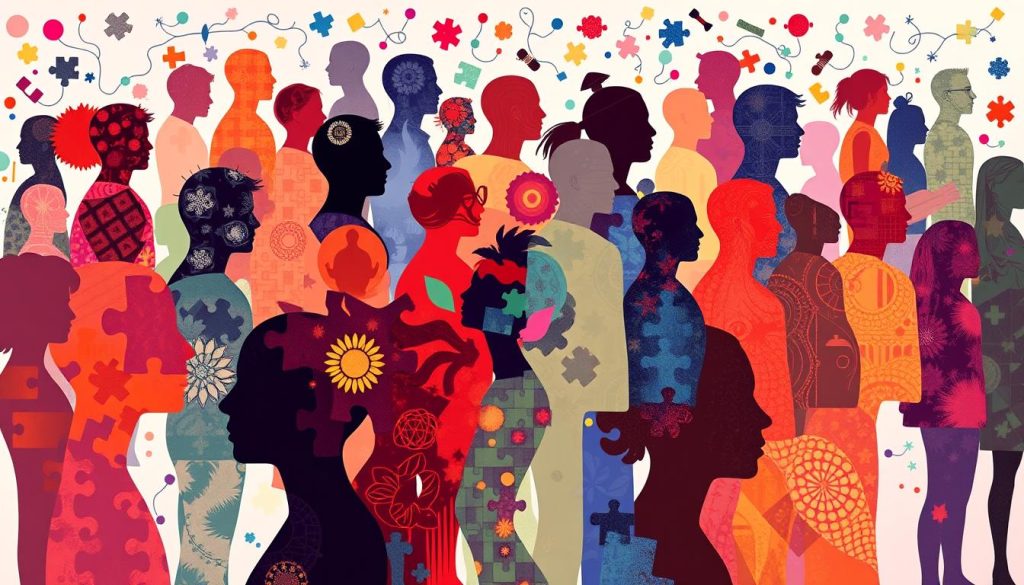
Strengths and Challenges
Those with autism spectrum traits have amazing strengths. They might be very detail-oriented, great at recognizing patterns, and intensely focused on what they love. But, they might struggle with social communication and handling sensory information.
Different Ways of Thinking
Autism spectrum individuals think differently. This can lead to new problem-solving methods and creative ideas. Some are great at visual thinking, while others understand complex systems well.
| Aspect | Neurotypical | Autism Spectrum |
|---|---|---|
| Social Interaction | Intuitive understanding | May require explicit learning |
| Information Processing | Holistic approach | Detail-oriented focus |
| Sensory Sensitivity | Average sensitivity | Often heightened sensitivity |
| Special Interests | Varied interests | Intense focus on specific topics |
Accepting neurodiversity in autism spectrum conditions makes society more inclusive. It helps create support systems that boost individual strengths and tackle challenges. This way, we value and understand diverse minds better.
Diagnosis Process and Assessment Methods
Getting a diagnosis for autism spectrum disorder is a detailed process. Trained professionals do the evaluation. They use screening tools to spot signs early.
Pediatricians often use questionnaires during check-ups to look for red flags. If they find concerns, they send families to specialists for deeper checks. These might include:
- Developmental pediatricians
- Child psychologists
- Speech-language pathologists
- Occupational therapists
The process of diagnosing autism involves watching the child’s behavior. It also looks at their communication and thinking skills. Specialists use tests and rating scales to collect data.
Getting a diagnosis early is key for help to start quickly. Studies show early support leads to better results. The criteria for autism diagnosis include:
| Area | Symptoms |
|---|---|
| Social Communication | Difficulty with social interactions, nonverbal cues |
| Repetitive Behaviors | Restricted interests, repetitive movements |
| Sensory Issues | Over or under-sensitivity to sensory input |
Every person with autism is different. A detailed assessment helps create support plans. This ensures they get the right help to succeed.
Early Signs and Intervention Strategies
Spotting ASD symptoms early can greatly impact a child’s life. Parents are key in noticing autism traits in young kids. Let’s look at the signs to watch for and how early intervention can help.
Recognition in Early Childhood
Autism signs often appear before age three. Kids might not make eye contact or respond to their name. They could have trouble sharing interests or playing pretend.
Some children repeat words or actions over and over.
Important Developmental Milestones
Tracking milestones is important to spot autism traits. Here are key skills to watch for:
- 6 months: Smiles and shows joy
- 9 months: Copies sounds and gestures
- 12 months: Uses simple gestures like waving
- 16 months: Says single words
- 24 months: Uses two-word phrases

Early Intervention Programs
Early help can boost skills for kids with ASD symptoms. Programs focus on language, social skills, and daily tasks. They might include speech therapy, behavior support, and special education.
Family training is also key to help parents understand their child’s needs.
| Intervention Type | Focus Areas | Benefits |
|---|---|---|
| Applied Behavior Analysis (ABA) | Communication, social skills, adaptive behaviors | Improves learning, reduces challenging behaviors |
| Speech Therapy | Language skills, social communication | Enhances verbal and non-verbal communication |
| Occupational Therapy | Daily living skills, sensory processing | Increases independence in everyday activities |
Supporting Individuals on the Autism Spectrum
Supporting people with autism spectrum conditions needs a personal touch. Each person’s needs are different, showing how varied autism can be. Support strategies work across different life stages and settings.
Educational support is key. Schools can offer special learning plans, classrooms that are easier on the senses, and training in social skills. These help students with autism do well in school and make friends.
In the workplace, making adjustments helps a lot. Employers can give out noise-cancelling headphones, flexible work hours, or clear instructions in writing. These changes let people with autism show their talents and work well with others.
Community resources also play a big part. Local autism groups offer places to meet, workshops on life skills, and help for families. These services help people with autism feel included and independent.
| Support Area | Examples |
|---|---|
| Education | Individualized education plans, sensory rooms, social skills groups |
| Workplace | Quiet workspaces, clear communication, flexible hours |
| Community | Support groups, recreational activities, life skills training |
Support needs change as people grow. Regular checks make sure people with autism get the right help when they need it. This helps them live happy and meaningful lives.
Current Research and Understanding
Research on autism spectrum disorder is growing, revealing its complex nature. Scientists are uncovering what causes it and improving our understanding.
Latest Scientific Findings
Recent studies have given us new insights into autism spectrum disorder. Brain imaging shows differences in how people with autism’s brains connect. This helps explain why they might struggle with social communication and sensory processing.
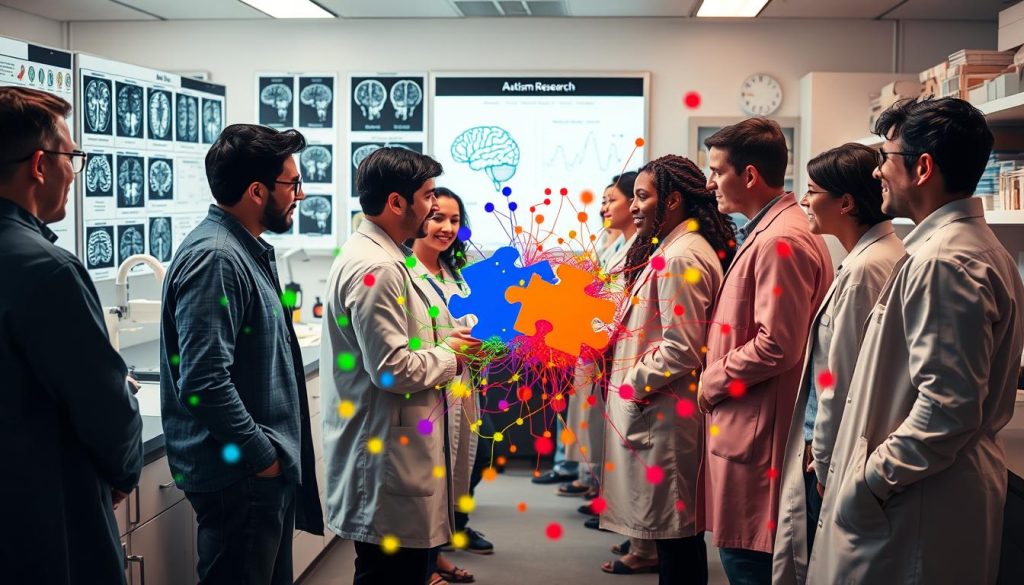
Genetic Factors
Genetics are a big part of autism spectrum causes. Over 100 genes have been found to increase the risk of autism. These genes affect how the brain develops and works. Twin studies show that autism often runs in families, with identical twins more likely to both have it.
Environmental Influences
Genetics aren’t the only factor. Environmental factors also play a role. Exposure to certain chemicals before birth, older parents, and pregnancy or birth complications can raise the risk. But, it’s important to remember that no single factor causes autism. The mix of genes and environment is complex.
As research goes on, we learn more about autism spectrum disorder. This knowledge helps us find better ways to support and help those on the autism spectrum.
Treatment Approaches and Therapies
Autism spectrum conditions need special care. Over time, treatments have grown to meet different needs. Let’s look at some effective ways to help those on the spectrum.
Behavioral interventions are key in treating autism. Applied Behavior Analysis (ABA) teaches new skills and reduces bad behaviors. It uses positive methods and structured learning.
Speech and language therapy is also important. It helps with communication challenges. Therapists work on verbal and non-verbal skills, making it easier for people to express themselves.
Occupational therapy is another essential part. It improves daily skills, fine motor, and sensory processing. This therapy boosts independence and quality of life.
| Treatment Approach | Focus Area | Benefits |
|---|---|---|
| Applied Behavior Analysis | Behavior modification | Skill development, reduced challenging behaviors |
| Speech Therapy | Communication | Improved verbal and non-verbal skills |
| Occupational Therapy | Daily living skills | Enhanced independence, sensory processing |
| Social Skills Training | Social interaction | Better peer relationships, social understanding |
Social skills training is becoming more important. It helps with social situations, understanding cues, and forming relationships. These efforts, along with personalized support, greatly improve life for those with autism.
Living with Autism: Personal Perspectives
Living with autism spectrum traits is both challenging and rewarding. Each person’s journey is unique. It’s shaped by their autism characteristics and life experiences.
Adult Experiences
Many adults with autism find success in their careers and personal lives. They learn to handle social interactions and sensory sensitivities. Some shine in fields like technology or arts, where their skills and interests align.
Family Impact
Autism impacts the whole family. Parents may feel more stress but also grow closer to their children. Siblings often become more empathetic and accepting of differences.
Families adapt their routines and communication to support their loved ones with autism. This helps everyone in the family.
Success Stories
Many people with autism achieve great success. Temple Grandin, diagnosed with autism as a child, became a famous animal behaviorist and author. Anthony Hopkins, a renowned actor, also has autism.
These stories highlight how autism can be a strength. With the right support, individuals with autism can lead fulfilling lives and contribute to society.
Resources and Support Networks
Finding the right resources and support networks is key for those with autism spectrum disorder and their families. The autism community has a lot to offer, from information to connection opportunities.
National organizations are a big help. The Autism Society of America and Autism Speaks have online libraries, educational materials, and advocacy resources. They help families understand autism and find local support groups.
Online communities are also very helpful. Forums like Wrong Planet and Reddit’s r/autism let people share experiences and advice. They offer a place for individuals on the spectrum and their loved ones to connect and find support.
- Local support groups
- Educational workshops
- Therapy resources
- Financial assistance programs
- Employment support services
Universities and research centers also offer special programs for autism. They provide the latest on treatments and educational strategies.
Using these resources can really improve life for those with autism and their families. Don’t be shy to reach out and find support in your community and online.
The Future of Autism Spectrum Understanding and Support
The autism spectrum definition is changing. New research is revealing how the brain works and the role of genetics. This knowledge will help make diagnoses more accurate and support plans tailored to each person.
New treatments for autism are coming. Virtual reality might help with social skills. Brain-computer interfaces could help those who can’t speak. These innovations aim to improve life and independence for those on the spectrum.
Our view of autism is changing too. There’s a push for accepting neurodiversity in schools and workplaces. This shift values autistic strengths. As we move forward, keeping awareness and education high is essential for a supportive world for all.
FAQ
Q: What is the autism spectrum?
A: The autism spectrum is a range of conditions. They affect how people communicate, behave, and process sensory information. Each person with autism is different, with their own set of traits and abilities.
Q: How is autism spectrum disorder (ASD) diagnosed?
A: Doctors diagnose ASD through a detailed evaluation. This includes using screening tools, observing behavior, and assessments by medical experts. The diagnosis follows the criteria in the Diagnostic and Statistical Manual of Mental Disorders (DSM-5).
Q: What are some common signs of autism?
A: Signs of autism include trouble with social interaction and communication. People with autism might also have repetitive behaviors, intense interests, and sensory sensitivities. Remember, symptoms vary greatly from person to person.
Q: Are there different levels of autism?
A: Yes, the DSM-5 defines three levels of support for ASD: Level 1, Level 2, and Level 3. These levels show the different amounts of help people with ASD might need in their daily lives.
Q: What causes autism spectrum disorder?
A: The exact causes of ASD are not known. Research points to a mix of genetic and environmental factors. Studies are ongoing to understand more about prenatal conditions and early childhood experiences.
Q: Can autism be cured?
A: Autism is a lifelong condition and cannot be “cured.” But, therapies and interventions can help people with ASD. They can develop skills, manage challenges, and improve their quality of life.
Q: What is neurodiversity?
A: Neurodiversity sees neurological differences, like autism, as natural variations. It promotes acceptance and celebration of these differences.
Q: What are some common treatments for autism?
A: Treatments for autism include behavioral therapies, speech and language therapy, occupational therapy, and social skills training. Each treatment plan is tailored to meet the unique needs of the individual.
Q: Can adults be diagnosed with autism?
A: Yes, adults can be diagnosed with autism. Many people, with milder symptoms, may not get diagnosed until adulthood. An adult diagnosis can help them access the right support services.
Q: How can I support someone with autism?
A: Supporting someone with autism means understanding their needs, being patient, and accepting them. Provide clear communication, respect their sensory sensitivities, and advocate for inclusive environments. It’s also important to celebrate their unique strengths and abilities.













